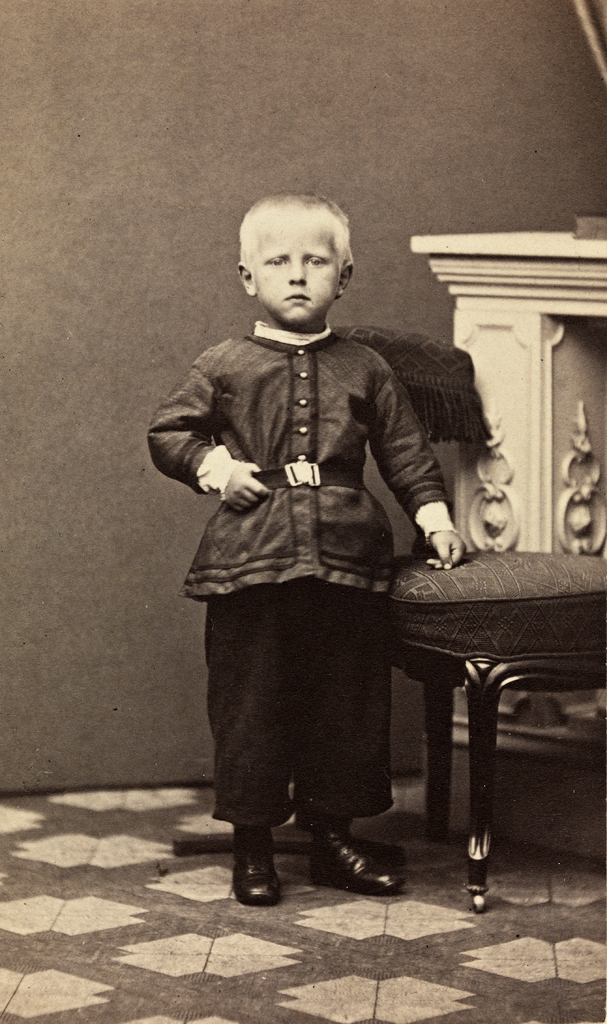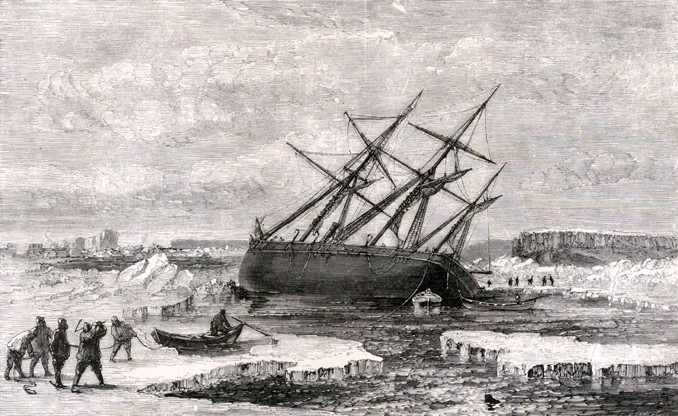|
Manhauling
Manhauling or man-hauling is the pulling forward of sledges, trucks or other load-carrying vehicles by human power unaided by animals (e.g. huskies) or machines. The term is used primarily in connection with travel over snow and ice, and was common during Arctic and Antarctic expeditions before the days of modern motorised traction. In the years following the end of the Napoleonic wars the British Royal Navy took up polar/cold climate exploration as its chief peacetime activity. Due to its simplicity, manhauling was adopted by the early British naval expeditions, where it quickly became the preferred even the 'traditional' technique. In time it would be hailed as inherently more noble than the sole use of dogs as practised by the native Arctic-dwelling peoples. The technique's chief advocate was Sir Clements Markham, President of the Royal Geographical Society during the latter part of the 19th century. A figure of considerable influence, he brought his prejudices to bear on the ... [...More Info...] [...Related Items...] OR: [Wikipedia] [Google] [Baidu] |
Sledge
A sled, skid, sledge, or sleigh is a land vehicle that slides across a surface, usually of ice or snow. It is built with either a smooth underside or a separate body supported by two or more smooth, relatively narrow, longitudinal runners similar in principle to skis. This reduces the amount of friction, which helps to carry heavy loads. Some designs are used to transport passengers or cargo across relatively level ground. Others are designed to go downhill for recreation, particularly by children, or competition. (Compare cross-country skiing with its downhill cousin.) Shades of meaning differentiating the three terms often reflect regional variations depending on historical uses and prevailing climate. In British English, ''sledge'' is the general term, and more common than ''sled''. ''Toboggan'' is sometimes used synonymously with ''sledge'' but more often to refer to a particular type of sledge without runners. ''Sleigh'' refers to a moderate to large-sized, usually ... [...More Info...] [...Related Items...] OR: [Wikipedia] [Google] [Baidu] |
Greenland
Greenland ( kl, Kalaallit Nunaat, ; da, Grønland, ) is an island country in North America that is part of the Kingdom of Denmark. It is located between the Arctic and Atlantic oceans, east of the Canadian Arctic Archipelago. Greenland is the world's largest island. It is one of three constituent countries that form the Kingdom of Denmark, along with Denmark and the Faroe Islands; the citizens of these countries are all citizens of Denmark and the European Union. Greenland's capital is Nuuk. Though a part of the continent of North America, Greenland has been politically and culturally associated with Europe (specifically Norway and Denmark, the colonial powers) for more than a millennium, beginning in 986.The Fate of Greenland's Vikings , by Dale Mackenzie Brown, ''Archaeological Institute of America'', ... [...More Info...] [...Related Items...] OR: [Wikipedia] [Google] [Baidu] |
Terra Nova Expedition
The ''Terra Nova'' Expedition, officially the British Antarctic Expedition, was an expedition to Antarctica which took place between 1910 and 1913. Led by Captain Robert Falcon Scott, the expedition had various scientific and geographical objectives. Scott wished to continue the scientific work that he had begun when leading the ''Discovery'' Expedition from 1901 to 1904, and wanted to be the first to reach the geographic South Pole. He and four companions attained the pole on 17 January 1912, where they found that a Norwegian team led by Roald Amundsen had preceded them by 34 days. Scott's party of five died on the return journey from the pole; some of their bodies, journals, and photographs were found by a search party eight months later. The expedition, named after its supply ship, was a private venture financed by public contributions and a government grant. It had further backing from the Admiralty, which released experienced seamen to the expedition, and from the Royal ... [...More Info...] [...Related Items...] OR: [Wikipedia] [Google] [Baidu] |
Edward Adrian Wilson
Edward Adrian Wilson (23 July 1872 – 29 March 1912) was an English polar explorer, ornithologist, natural historian, physician and artist. Early life Born in Cheltenham on 23 July 1872, Wilson was the second son and fifth child of physician Edward Thomas Wilson and his wife, Mary Agnes, née Whishaw. A clever, sensitive, but boisterous boy, he developed a love of the countryside, natural history and drawing from an early age. He was sent as a boarder to a preparatory school in Clifton, Bristol, but after failing to gain a scholarship to public school, he attended Cheltenham College for boys as a day pupil. His mother was a poultry breeder and he spent much of his youth at The Crippetts farm, Leckhampton near Cheltenham. By the age of nine, he had announced to his parents that he was going to become a naturalist. With encouragement and tuition from his father, he started to draw pictures of the wildlife and fauna in the fields around the farm. After passing his exams ... [...More Info...] [...Related Items...] OR: [Wikipedia] [Google] [Baidu] |
Fridtjof Nansen
Fridtjof Wedel-Jarlsberg Nansen (; 10 October 186113 May 1930) was a Norwegian polymath and Nobel Peace Prize laureate. He gained prominence at various points in his life as an explorer, scientist, diplomat, and humanitarian. He led the team that made the first crossing of the Greenland interior in 1888, traversing the island on cross-country skis. He won international fame after reaching a record northern latitude of 86°14′ during his ''Fram'' expedition of 1893–1896. Although he retired from exploration after his return to Norway, his techniques of polar travel and his innovations in equipment and clothing influenced a generation of subsequent Arctic and Antarctic expeditions. Nansen studied zoology at the Royal Frederick University in Christiania and later worked as a curator at the University Museum of Bergen where his research on the central nervous system of lower marine creatures earned him a doctorate and helped establish neuron doctrine. Later, neuroscientist Sa ... [...More Info...] [...Related Items...] OR: [Wikipedia] [Google] [Baidu] |
Ernest Shackleton
Sir Ernest Henry Shackleton (15 February 1874 – 5 January 1922) was an Anglo-Irish Antarctic explorer who led three British expeditions to the Antarctic. He was one of the principal figures of the period known as the Heroic Age of Antarctic Exploration. Born in Kilkea, County Kildare, Ireland, Shackleton and his Anglo-Irish family moved to Sydenham in suburban south London when he was ten. Shackleton's first experience of the polar regions was as third officer on Captain Robert Falcon Scott's ''Discovery'' expedition of 1901–1904, from which he was sent home early on health grounds, after he and his companions Scott and Edward Adrian Wilson set a new southern record by marching to latitude 82°S. During the ''Nimrod'' expedition of 1907–1909, he and three companions established a new record Farthest South latitude at 88°S, only 97 geographical miles (112 statute miles or 180 kilometres) from the South Pole, the largest advance to the pole in ... [...More Info...] [...Related Items...] OR: [Wikipedia] [Google] [Baidu] |
Discovery Expedition
The ''Discovery'' Expedition of 1901–1904, known officially as the British National Antarctic Expedition, was the first official British exploration of the Antarctic regions since the voyage of James Clark Ross sixty years earlier (1839–1843). Organized on a large scale under a joint committee of the Royal Society and the Royal Geographical Society (RGS), the new expedition carried out scientific research and geographical exploration in what was then largely an untouched continent. It launched the Antarctic careers of many who would become leading figures in the Heroic Age of Antarctic Exploration, including Robert Falcon Scott who led the expedition, Ernest Shackleton, Edward Wilson, Frank Wild, Tom Crean (explorer), Tom Crean and William Lashly. Its scientific results covered extensive ground in biology, zoology, geology, meteorology and magnetism. The expedition discovered the existence of the only McMurdo Dry Valleys, snow-free Antarctic valleys, which contains the lon ... [...More Info...] [...Related Items...] OR: [Wikipedia] [Google] [Baidu] |
Robert Falcon Scott
Captain Robert Falcon Scott, , (6 June 1868 – c. 29 March 1912) was a British Royal Navy officer and explorer who led two expeditions to the Antarctic regions: the ''Discovery'' expedition of 1901–1904 and the ill-fated ''Terra Nova'' expedition of 1910–1913. On the first expedition, he set a new southern record by marching to latitude 82°S and discovered the Antarctic Plateau, on which the South Pole is located. On the second venture, Scott led a party of five which reached the South Pole on 17 January 1912, less than five weeks after Amundsen's South Pole expedition. A planned meeting with supporting dog teams from the base camp failed, despite Scott's written instructions, and at a distance of 162 miles (261 km) from their base camp at Hut Point and approximately 12.5 miles (20 km) from the next depot, Scott and his companions died. When Scott and his party's bodies were discovered, they had in their possession the first Antarctic fossils ever discov ... [...More Info...] [...Related Items...] OR: [Wikipedia] [Google] [Baidu] |
Franklin's Lost Expedition
Franklin's lost expedition was a failed British voyage of Arctic exploration led by Captain Sir John Franklin that departed England in 1845 aboard two ships, and , and was assigned to traverse the last unnavigated sections of the Northwest Passage in the Canadian Arctic and to record magnetic data to help determine whether a better understanding could aid navigation. The expedition met with disaster after both ships and their crews, a total of 129 officers and men, became icebound in Victoria Strait near King William Island in what is today the Canadian territory of Nunavut. After being icebound for more than a year ''Erebus'' and ''Terror'' were abandoned in April 1848, by which point Franklin and nearly two dozen others had died. The survivors, now led by Franklin's second-in-command, Francis Crozier, and ''Erebus''s captain, James Fitzjames, set out for the Canadian mainland and disappeared, presumably having perished. Pressed by Franklin's wife, Jane, and others, t ... [...More Info...] [...Related Items...] OR: [Wikipedia] [Google] [Baidu] |
Francis Leopold McClintock
Sir Francis Leopold McClintock (8 July 1819 – 17 November 1907) was an Irish explorer in the British Royal Navy, known for his discoveries in the Canadian Arctic Archipelago. He confirmed explorer John Rae's controversial report gathered from Inuit sources on the fate of Franklin's lost expedition, the ill-fated Royal Navy undertaking commanded by Sir John Franklin in 1845 attempting to be the first to traverse the Northwest Passage. McClintock's report was received more favorably than that of Rae, who was shunned and denied recognition for having discovered the lost expedition's fate. Rae's report ultimately guided McClintock to the correct area to conduct a search. McClintock also stirred controversy with his claim that Franklin, before his death, had essentially discovered the Northwest Passage, while in reality he had not. Rae, with his discovery of Rae Strait, had discovered the real ice-free passage through North America's Arctic archipelago. Early life McClint ... [...More Info...] [...Related Items...] OR: [Wikipedia] [Google] [Baidu] |
Melville Island (Northwest Territories And Nunavut)
Melville IslandCoordinates are located on the NWT side. (french: Île Melville; Inuktitut: ''ᐃᓗᓪᓕᖅ, Ilulliq'') is an uninhabited island of the Arctic Archipelago with an area of . It is the 33rd largest island in the world and Canada's eighth largest island. Mountains on Melville Island, some of the largest in the western Canadian Arctic, reach heights of . There are two subnational pene-exclaves that lie west of the 110th meridian and form part of the Northwest Territories. These can only be reached by land from Nunavut or boat from the Northwest Territories. Melville Island is shared by the Northwest Territories, which is responsible for the western half of the island, and Nunavut, which is responsible for the eastern half. The border runs along the 110th meridian west. Geography The island has little or no vegetation. Where continuous vegetation occurs, it usually consists of hummocks of mosses, lichens, grasses, and sedges. The only woody s ... [...More Info...] [...Related Items...] OR: [Wikipedia] [Google] [Baidu] |








